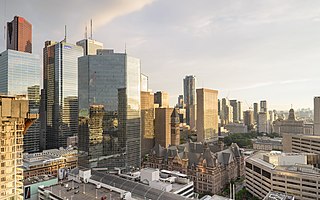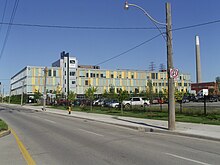Present-day telecommunications in Canada include telephone, radio, television, and internet usage. In the past, telecommunications included telegraphy available through Canadian Pacific and Canadian National.

The Toronto Stock Exchange is a stock exchange located in Toronto, Ontario, Canada. It is the 10th largest exchange in the world and the third largest in North America based on market capitalization. Based in the EY Tower in Toronto's Financial District, the TSX is a wholly owned subsidiary of the TMX Group for the trading of senior equities.

Canada has a large domestic and foreign tourism industry. The second largest country in the world, Canada's wide geographical variety is a significant tourist attractor. Much of the country's tourism is centred in the following regions: Toronto, Montreal, Quebec City, Vancouver/Whistler, Niagara Falls, Vancouver Island, Canadian Rockies, British Columbia's Okanagan Valley, Churchill, Manitoba and the National Capital Region of Ottawa-Gatineau. The large cities are known for their culture, diversity, as well as the many national parks and historic sites.

The Bank of Nova Scotia, operating as Scotiabank, is a Canadian multinational banking and financial services company headquartered in Toronto, Ontario. One of Canada's Big Five banks, it is the third-largest Canadian bank by deposits and market capitalization. In 2023, the company’s seat in Forbes Global 2000 was 88. It serves more than 25 million customers around the world and offers a range of products and services including personal and commercial banking, wealth management, corporate and investment banking. With more than 92,001 employees and assets of Can$1,136 billion, Scotiabank trades on the Toronto and New York exchanges. The Scotiabank swift code is NOSCCATT and the institution number is 002.

Rogers Communications Inc. is a Canadian communications and media company operating primarily in the fields of wireless communications, cable television, telephony and Internet, with significant additional telecommunications and mass media assets. Rogers has its headquarters in Toronto, Ontario.
Hollywood North is a colloquialism used to describe film production industries and/or film locations north of its namesake, Hollywood, California. The term has been applied principally to the film industry in Canada, specifically to the cities Toronto and Vancouver.

Bay Street is a major thoroughfare in Downtown Toronto, Ontario, Canada. It is the centre of Toronto's Financial District and is often used by metonymy to refer to Canada's financial services industry since succeeding Montreal's St. James Street in that role in the 1970s.

Scotiabank Arena, formerly known as Air Canada Centre (ACC), is a multi-purposed arena located on Bay Street in Downtown Toronto, Ontario, Canada. It is the home of the Toronto Raptors of the National Basketball Association (NBA) and the Toronto Maple Leafs of the National Hockey League (NHL). In addition, the minor league Toronto Marlies of the American Hockey League (AHL) and the Raptors 905 of the NBA G League play occasional games at the arena. The arena was previously home to the Toronto Phantoms of the Arena Football League (AFL) and the Toronto Rock of the National Lacrosse League. Scotiabank Arena also hosts other events, such as concerts, political conventions and video game competitions.
Big Five is the name colloquially given to the five largest banks that dominate the banking industry of Canada: Bank of Montreal (BMO), Scotiabank, Canadian Imperial Bank of Commerce (CIBC), Royal Bank of Canada (RBC), and Toronto-Dominion Bank (TD).

Path is a network of underground pedestrian tunnels, elevated walkways, and at-grade walkways connecting the office towers of Downtown Toronto, Ontario, Canada. It connects more than 70 buildings via 30 kilometres (19 mi) of tunnels, walkways, and shopping areas. According to Guinness World Records, Path is the largest underground shopping complex in the world, with 371,600 square metres (4,000,000 sq ft) of retail space which includes over 1,200 retail fronts (2016). As of 2016, over 200,000 residents and workers use the Path system daily with the number of private dwellings within walking distance at 30,115.

Chicago and its suburbs is home to 35 Fortune 500 companies and is a transportation and distribution center. Manufacturing, printing, publishing, insurance, transportation, financial trading and services, and food processing also play major roles in the city's economy. The total economic output of Chicago in gross metropolitan product totaled US$770.7 billion in 2020, surpassing the total economic output of Switzerland and making Chicago's gross metropolitan product (GMP) the third largest in the United States, after New York and Los Angeles. The city is home to several Fortune 500 companies, including Archer Daniels Midland, Conagra Brands, Exelon, JLL, Kraft Heinz, McDonald's, Mondelez International, Motorola Solutions, Sears, and United Airlines Holdings, although Chicago has experienced an exodus of large corporations since 2020, including Boeing; Citadel LLC; Caterpillar; and Tyson Foods. Three Fortune 500 companies left Chicago in 2022, leaving the city with 35, still second to New York City.

Cineplex Inc. is a Canadian operator of movie theater and family entertainment centres, headquartered in Toronto. It is the largest cinema chain in Canada; as of 2019, it operated 165 locations, and accounted for 75% of the domestic box office.

Saint Jacques Street, or St. James Street, is a major street in Montreal, Quebec, Canada, running from Old Montreal westward to Lachine.

Toronto is the largest city in Canada and one of the most multicultural cities in the world. Many immigrant cultures have brought their traditions languages and music to Toronto. Toronto, the capital of the province of Ontario, is a major Canadian city along Lake Ontario's northwestern shore. It's a dynamic metropolis with a core of soaring skyscrapers, all dwarfed by the iconic, free-standing CN Tower. Toronto also has many green spaces, from the orderly oval of Queen's Park to 400-acre High Park and its trails, sports facilities and zoo.

Downtown Toronto is the main central business district of Toronto, Ontario, Canada. Located entirely within the district of Old Toronto, it is approximately 16.6 square kilometres in area, bounded by Bloor Street to the northeast and Dupont Street to the northwest, Lake Ontario to the south, the Don Valley to the east, and Bathurst Street to the west. It is also the home of the municipal government of Toronto and the Government of Ontario.

Banking in Canada is one of Canada's most important industries with several banks being among its largest and most profitable companies.

The Financial District is the central business district of Downtown Toronto, Ontario, Canada. It was originally planned as New Town in 1796 as an extension of the Town of York. It is the main financial district in Toronto and is considered the heart of Canada's finance industry. It is bounded roughly by Queen Street West to the north, Yonge Street to the east, Front Street to the south, and University Avenue to the west, though many office towers in the downtown core have been and are being constructed outside this area, which will extend the general boundaries. Examples of this trend are the Telus Harbour, RBC Centre, and CIBC Square.

Canada's cities span the continent of North America from east to west, with many major cities located relatively close to the border with the United States. Cities are home to the majority of Canada's approximately 35.75 million inhabitants —just over 80 percent of Canadians lived in urban areas in 2006.

Montreal's economy is the second largest of all cities in Canada and the first in Quebec. Montreal is a centre of commerce, industry, technology, culture, finance, and world affairs. In 2022, Metropolitan Montreal was responsible for $233 Billion CDN of Quebec's $425 Billion CDN GDP, with a population of 4.37 million people. Montreal's economy, therefore, comprises approximately 54.8% of Quebec's overall GDP.






















